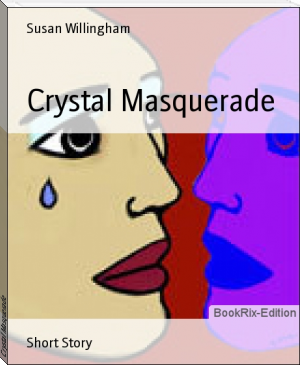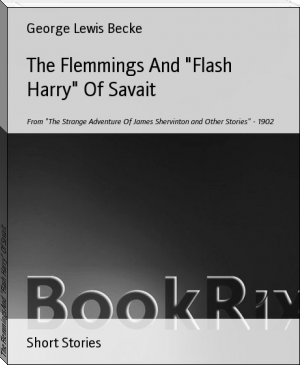"Five-Head" Creek; and Fish Drugging In The Pacific by George Lewis Becke (inspirational books .TXT) 📖

- Author: George Lewis Becke
Book online «"Five-Head" Creek; and Fish Drugging In The Pacific by George Lewis Becke (inspirational books .TXT) 📖». Author George Lewis Becke
I leant over the bank and looked down, and then gave a start of pleasure, for right beneath me were three fish floating motionless on the surface--fish that, until then, I never knew lived in fresh water. They were in shape, colour, and appearance exactly like the toothed gar so common on the sea coast--a long slender body with back of dark blue, sides of silvery white, and fins and tail of blue tipped with yellow. I was so excited that I was about to shoot them, but remembered that at so short a distance I should have only blown them to pieces, especially as they were directly beneath me. I motioned to the blackboys to come and look; they did so, and I learnt that these fish, when the creek was low, were sometimes plentiful, and would take almost any floating bait, especially if it were alive.
Eager to begin, I told the boys to collect some crayfish for bait, but they said that it would take too long, and small fish were better, and running to some small lily-covered pools about two feet in diameter, and very shallow, they jumped in and stirred up the sand and muddy sediment at the bottom. In a few minutes some scores of very pretty red and silvery-hued minnows were thrown out on the sand. I quickly baited my line, and threw it, with the sinker attached, into the centre of the pool; before it could sink the bait was taken by a fine bream of 2 lbs., which I landed safely, and tossed to the boys. It was the first fresh-water bream I had caught in Queensland, and I felt elated.
Finding that the pool was clear of snags, I bent on three extra hooks, baiting each one with the whole of a tiny fish. Again the baits were seized before they reached the bottom; I hauled in two more bream, and as they came struggling and splashing into the shallow water I saw they were being followed by literally hundreds of the same species, and also by fish much like an English grayling--the pool seemed to be alive! The presence of such large numbers in so circumscribed a space could, however, be easily accounted for by the absence of rain for so many months, the drying up of many minor pools and stretches, and the diminution of the water generally throughout the creek and its tributaries driving the fish to congregate in the deeper and larger pools.
By noon I had caught as many fish as the boys could carry. None, it is true, were very large, 2 1/2 lbs. being the heaviest; but I was pleased to learn that there were places farther down the creek where the blacks frequently caught some very large cat-fish; when the water was muddy from heavy rain. These cat-fish, or, as some people call them, "jew-fish," are the heaviest and best of all the Queensland river fish I have ever tasted, except those which, for want of their true name, I called grayling, and Hansen asserted were trout.
Sending the black boys off with the fish, I cut a rod from a she-oak and quickly rigged a line; for a float I used a small piece of dead wood, and baited with the largest minnow I could find. Then, clambering up the bank, I found a suitable open place to stand at the butt of a Leichhardt, from where I had a good view. I could not, however, see any of the gars, one at least of which I was so anxious to get, but made a cast into the centre--and almost instantly one darted out from under the lily leaves and hooked himself beautifully, but in swinging him out my line fouled a thorny bush, and for a minute I was in despair; there was the shining beauty suspended over the water, and almost making a circle of his body in his struggle to escape. At last, however, I cleared my line, and swung my prize high up on the bank. Determined to get a better rod, and return after dinner, I picked up gun and fish and followed the boys.
By sunset I had a catch of fish that fairly astonished Hansen when he returned at dusk with but half a dozen black duck, two or three teal, and two turkeys. All that evening we were employed in cleaning and salting the fish and birds, except some for immediate use.
We had many such days. Fish were to be had all throughout the course of the creek, and had we possessed a net like those the blacks sometimes used, we could have taken a hogsheadful in half an hour.
Then, as the rainy season began, I ceased fishing and took to the gun, for now three or four kinds of duck made their appearance, and one moonlight night an immense number alighted in the creek just below the hut, and kept up an incessant gabble and quacking till sunrise.
In less than ten days we had enough salted game and dried and smoked fish to last us three months, even had we eaten nothing else. Our black friends--with the exception of one lad who desired to remain--left us one morning at sunrise, and we saw them no more. I am afraid they were deeply hurt by our poisoning half a dozen of their mangy dogs, which were, with the rest of the pack, a continual source of annoyance to us by their expert thieving.
One dull, rainy day, as we sat indoors mending our clothes, and yarning and smoking, we heard the scream of parrots, and, going to the door, saw some twenty or thirty of them, large, fine, green and scarlet plumaged birds, hanging on to and crawling in and out among the branches of some low trees growing between the stockyard and the creek. These trees were a species of wattle, and were just opening out their yellow, sweet-smelling, downy flowers, which the beautiful birds were devouring eagerly. We did not disturb them, and they did not appear to be alarmed when we walked up to within a few yards of the trees, merely screaming defiance, and flying up to the higher branches, or to other trees near by. These birds the local settlers called "king-parrots"; they were larger than those of the same species in New South Wales, and later in the season we shot a few of them for soup. This particular flock visited us for many days in succession, forming a pretty picture as they hung on the branches, chattering loudly the while, and flashing their gaily-coloured plumage in the bright sunshine. Like the spur-winged plover, they were very inquisitive birds; if one of their number was shot, and fell wounded, the rest of the flock would fly round and round the poor creature, watching its movements and listening to its cries, not out of pity, but of sheer curiosity, and each could be shot in succession, or sometimes knocked down with a stick. I was told by a stockman on Fanning Downs station that on several occasions when he had wounded birds of this variety of the parrot tribe, their companions descended upon them with fury, tore out their feathers, and bit and lacerated them savagely.
Now and again a few wandering emus would cross the grey gum plains around us, and then, as they caught sight of our figures, shamble quickly off again. In former years they had been plentiful in the district, and provided good food for the aborigines when the latter organised their big hunting parties. But as the country was taken up as cattle runs, hundreds of the great birds were wantonly shot by white men for the mere pleasure of killing, and all the months we lived in the district we did not see more than twenty.
I have before spoken of the number of snakes that were everywhere to be seen in the vicinity of the water, particularly about pools with a reedy margin. Scarcely a week passed without our killing three or four, and we were always careful in bathing to do so in very shallow water, where there was a clear sandy bottom. There were three kinds of water-snakes, one of which was of a dull blue colour, and these the blacks said were "bad fellow," _i.e._, venomous. They seldom grew over two feet and a half in length, and on a bright day one might see several of these reptiles swimming across from one bank to the other. Of the common brown snake--the kind we most dreaded--and the black-necked tiger snake, we killed numbers with our guns and with sticks, and one day, when crossing some red ironstone ridges on the Ravenswood road, we despatched two death-adders which were lying asleep on the bare, hot road. They were of a dull reddish brown, the same hue as the ground in the ironstone country, just as they are a yellowish brown in a sandstone region.
One great pest to us when fishing were the number of mud turtles, greedy little creatures which persistently swallowed our hooks, which could only be recovered by placing one's foot on their backs, drawing out their long snaky necks to the utmost tension, and cutting off their heads; the other pests were the hideous flabby water iguanas (I do not know their proper name), which, although they never interfered with our lines, sickened us even to look at them. They were always to be seen lying on a log or snag in the water. As you approached they either crawled down like an octopus, or dropped, in a boneless, inert mass, without a splash. Their slimy, scaleless skins were a muddy yellow, and in general they resembled an eel with legs. Even the blacks looked on them with disgust, though they are particularly fond of the ordinary iguana.
The time passed somewhat wearily to us when heavy rains and flooded country kept us indoors for days together. Then one night after the weather had begun to get cooler and clearer, we heard, far, far overhead, the _honk, honk_ of the wild geese, flying southwards to distant lagoons, and Hansen reminded me that in another week our term of service came to an end.
"What made you think of it?" I asked.
"The cry of the wild geese going South."
For we, too, longed for the South again.
FISH DRUGGING IN THE PACIFIC
In an American magazine of a few months ago mention was made of the "discovery" of a method of capturing fish by impregnating the waters of slowly running rivers or small lakes with a chemical which would produce stupefaction, and cause the fish to rise helpless to the surface. The American discoverer no doubt thought he really had "discovered," though I am sure many thousands of people in the civilised world have heard of, and some few hundreds very often seen, fish captured in a somewhat similar manner, the which is, I believe, practised not only in India, Africa and South America, but in the islands of the North and South Pacific, and I have no doubt but that it was known thousands of years ago--perhaps even "when the world was young."
Nearly all the Malayo-Polynesian people inhabiting the high, mountainous islands of the South Pacific and North Pacific Oceans can, and do, catch fish in the "novel" manner before mentioned, _i.e._, by producing stupefaction, though no chemicals are used, while even the Australian aborigines--almost as low a type of savage as the





Comments (0)